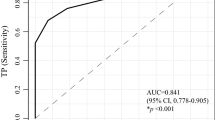Abstract
To investigate whether there is any association between nasopharyngeal reflux and adenoid hypertrophy in children by using 24-h pH monitoring with dual probe and to determine whether Helicobacter pylori simply colonises in adenoid tissue or it is present there temporarily due to extraesophageal reflux. A prospective study at a tertiary referral center. Thirty-two patients who underwent adenoidectomy, aged ranged between 4 and 13 were included. All children with adenoid hypertrophy underwent 24-h pH monitoring with a dual probe. Proximal probe was placed in the nasopharynx. The presence of nasopharyngeal reflux and gastroesophageal reflux were investigated by 24-h pH monitoring. The presence of H. pylori was investigated in adenoidectomy samples by HP-fast test. Of the 32 patients who underwent adenoidectomy, 5 had nasopharyngeal reflux positivity while 27 patients did not show nasopharyngeal reflux positivity with pH monitorisation. Helicobacter pylori could not be detected in 5 nasopharyngeal reflux positive children while 3 of 27 nasopharyngeal reflux negative children showed H. pylori positivity, one of them in the mucosa and others in the core. This study demonstrated the high incidence of nasopharyngeal reflux and gastroesophageal reflux in adenoid hypertrophy and the possible colonisation of H. pylori in the adenoid tissue. This may change the assesment of children with adenotonsillar hypertrophy in near future. However, more placebo controlled and double blind studies and larger series are still needed to support this hypothesis.
Similar content being viewed by others
References
Wiatrak BJ, Woolley AL (1998) Pharyngitis and adenotonsillar disease. In: Cummings CW, Fredrickson JM, Harker LA, Krause CJ, Richardson MA, Schuller DE (eds) Pediatric otolaryngology head & neck surgery, 3rd edn. Mosby, St. Louis, pp 198–202
Keles B, Ozturk K, Arbag H, Gunel E, Ozer B (2005) Frequency of pharyngeal reflux in children with adenoid hyperplasia. Int J Pediatr Otorhinolaryngol 69:1103–1107
Monroy A, Behar P, Brodsky L (2008) Revision adenoidectomy—a retrospective study. Int J Pediatr Otorhinolaryngol 72:565–570
Stapleton A, Brodsky L (2008) Extra-esophageal acid reflux induced adenotonsillar hyperplasia: case report and literature review. Int J Pediatr Otorhinolaryngol 72:409–413
Carr MM, Poje CP, Ehrig D, Brodsky LS (2001) Incidence of reflux in young children undergoing adenoidectomy. Laryngoscope 111:2170–2172
Lukes P, Astl J, Pavlík E, Potuzníková B, Sterzl I, Betka J (2008) Helicobacter pylori in tonsillar and adenoid tissue and its possible role in oropharyngeal carcinogenesis. Folia Biol (Praha) 54:33–39
Unver S, Kubilay U, Sezen OS, Coskuner T (2001) Investigation of Helicobacter pylori colonization in adenotonsillectomy specimens by means of the CLO test. Laryngoscope 111:2183–2186
Koufman JA (1991) The otolaryngologic manifestations of gastroesophageal reflux disease (GERD): a clinical investigation of 225 patients using ambulatory 24-hour pH monitoring and an experimental investigation of the role of acid and pepsin in the development of laryngeal injury. Laryngoscope 101:1–78
Phipps CD, Wood WE, Gibson WS, Cochran WJ (2000) Gastroesophageal reflux contributing to chronic sinus disease in children: a prospective analysis. Arch Otolaryngol Head Neck Surg 126:831–836
Suskind DL, Zeringue GP III, Kluka EA, Udall J, Liu DC (2001) Gastroesophageal reflux and pediatric otolaryngologic disease: the role of antireflux surgery. Arch Otolaryngol Head Neck Surg 127:511–514
Contencin P, Maurage C, Ployet MJ, Seid AB, Sinaasappel M (1995) Gastroesophageal reflux and ENT disorders in childhood. Int J Pediatr Otorhinolaryngol 32:135–144
Halstead LA (1999) Role of gastroesophageal reflux in pediatric upper airway disorders. Otolaryngol Head Neck Surg 120:208–214
Richter JE, Bradley LA, DeMeester TR, Wu WC (1992) Normal 24-hr ambulatory esophageal pH values. Influence of study center, pH electrode, age, and gender. Dig Dis Sci 37:849–856
Tumgor G, Midilli R, Yuksekkaya HA, Cakir M, Ozgenc F, Yagci RV (2006) Larengopharengeal reflux in patients with severe adeno-tonsil hyperplasia. Int J Pediatr Otorhinolaryngol 70:761–762
Eyigor M, Eyigor H, Gultekin B, Aydin N (2009) Detection of Helicobacter pylori in adenotonsiller tissue specimens by rapid urease test and polymerase chain reaction. Eur Arch Otorhinolaryngol 266:1611–1613
Jelavic B, Bevanda M, Ostojic M, Leventic M, Vasilj M, Knezevic E (2007) Tonsillar colonization is unlikely to play important role in Helicobacter pylori infection in children. Int J Pediatr Otorhinolaryngol 71:585–590
Khademi B, Niknejad N, Gandomi B, Yeganeh F (2007) Comparison of Helicobacter pylori colonization on the tonsillar surface versus tonsillar core tissue as determined by the CLO test. Ear Nose Throat J 86:498–501
Cirak MY, Ozdek A, Yilmaz D, Bayiz U, Samim E, Turet S (2003) Detection of Helicobacter pylori and its CagA gene in tonsil and adenoid tissues by PCR. Arch Otolaryngol Head Neck Surg 129:1225–1229
Bulut Y, Agacayak A, Karlidag T, Toraman ZA, Yilmaz M (2006) Association of cagA + Helicobacter pylori with adenotonsillar hypertrophy. Tohoku J Exp Med 209:229–233
Bitar MA, Soweid A, Mahfouz R, Zaatari G, Fuleihan N (2005) Is Helicobacter pylori really present in the adenoids of children? Eur Arch Otorhinolaryngol 262:987–992
Yilmaz M, Kara CO, Kaleli I, Demir M, Tümkaya F, Büke AS, Topuz B (2004) Are tonsils a reservoir for Helicobacter pylori infection in children? Int J Pediatr Otorhinolaryngol 68:307–310
Pitkaranta A, Kolho KL, Rautelin H (2005) Helicobacter pylori in children who are prone to upper respiratory tract infections. Arch Otolaryngol Head Neck Surg 131:256–258
Acknowledgments
We would like to thank to S Ergöçen for statistical analysis of the data and to Dr.D. Tepe for his help in data collection. We did not accept any financial and material support for this research.
Conflict of Interest
The authors declare that they have no conflict of interest.
Author information
Authors and Affiliations
Corresponding author
Rights and permissions
About this article
Cite this article
Aydın, E., Aydoğan, F., Taştan, E. et al. Does Helicobacter Pylori Have a Role in the Etiology of Adenoid Hypertrophy?. Indian J Otolaryngol Head Neck Surg 66 (Suppl 1), 65–70 (2014). https://doi.org/10.1007/s12070-011-0310-y
Received:
Accepted:
Published:
Issue Date:
DOI: https://doi.org/10.1007/s12070-011-0310-y




